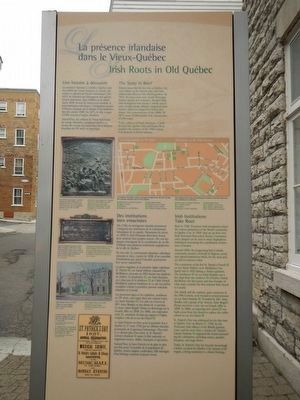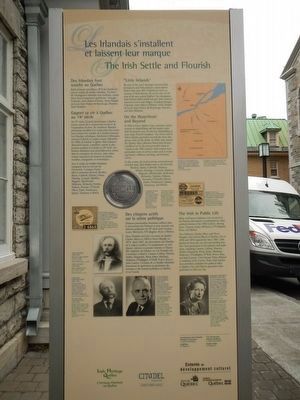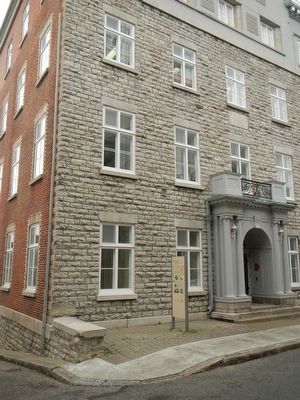Haute-Ville in Québec in Communauté-Urbaine-de-Québec, — Central Canada (French-Canadian)
Irish Roots in Old Québec
The Irish Settle and Flourish
— La présence irlandaise dans le Vieux-Québec / Les Irlandais s'installent et laissent leur marque —

Photographed By Barry Swackhamer, July 28, 2014
1. Irish Roots in Old Québec Marker, Side A
Captions (English / French): (map on right) Old Québec in the 19th Century / Le Vieux Québec au 19ᵉ siècle; The numbers refer to the text describing the location of the Irish institutions first established in the Old City. / Les numeros renvoient au texte et marquent l'emplacement des lieux témoins de la présence irlandaise dans le Vieux-Québec, ① Monument to Cardinal Taschereau / Monument au cardinal Taschereau, ② St. Patrick;s Church / Église St. Patrick, ③ Presbytery / Presbytère, ④ Residence of Father McMahon / Résidence du curé McMahon, ⑤ Saint Brigid's Home, ⑥ St. Patrick's second school / Deuxiéme école St. Patrick, ⑦ St. Patrick;s original school / Première école St. Patrick, ⑧ St. Patrick's Literary Institute.; (upper left) ① Bas relief of the monument to Cardinal Taschereau (1820-1898), City Hall Square, showing young Father Taschereau ministering to the Irish immigrant on Grosse-Île, in 1847. / Bas-relief du monument au cardinal Taschereau (1820-1898), place du l'Hôtel-de-Vile. On y voit le jeune abbé Taschereau avec les immigrants irlandais à Grosse-Île, en 1847.; (center left) Plaque honoring the memory of James Brain O'Regan (1875-1951) for his role in the public playgrounds movement in Québec City. Located in the former St. Matthews Church, rue Saint-Jean. / Plaque soulignant l'aport de James Brain O'Regan (1875-1951) à l'établissement des terrains de jeux dans la ville de Québec. Crete plaque se troupe dans l'ancienne église St. Matthew située la rue Saint-Jean.; (center left) Saint Brigid's Home circa 1970. Painting by James Halpin, well known Québec City artist. / Saint Brigid's Home vers 1970. Tableau de James Halpin, peintre réputé de Québec.; (bottom left) St. Patrick's Day. Advertisement for Variety Show celebrating the national feast day of the Irish, March 17, 1867. / La Saint-Patrick. Publicité d'un spectacle soulignant la célèbration de la fête des Irlandais, le 17 mars 1867.
Side A
English:
The Story in Brief
History notes that the first Irish in Quebec City were soldiers in the French army and, later, soldiers and officers of the British garrison. By 1815, the newcomers were mostly Protestant business people and craftsmen. Around I830, Irish immigrants were mainly Catholic and of more modest means. Massive emigration from Ireland, which was plagued by famine and disease, was a phenomenon of the 1840s. By 1871, some 12,500 Québec City citizens were of Irish origin.
Today, millions of North Americans of Irish descent view Quebec City and Grosse-Île as sacred to the memory of the 19th Century Irish diaspora in North America.
Irish Institutions Take Root
Back in 1760, Protestant Irish immigrants joined the various institutions of the British community in Quebec City. In 1859, they set up their own Irish Protestant Benevolent Society. Commemorative plaques can be seen in many Anglophone institutions honouring the contribution of these sons of Ireland.
Around 1830, the burgeoning Irish Catholic community created a network of religious, social, and cultural institutions which, for the most part, are still in existence today.
The cornerstone of the first St. Patrick’s Church ② on rue Sainte-Helene (now McMahon) was hastily laid in 1832 during a cholera epidemic. The presbytery ③ on rue Saint~Stanislas was a few steps from the residence ④ of Father Patrick McMahon, the first pastor and thus founder of what many consider the first national Irish church in Canada.
The elderly and the orphans, quite numerous in the 19th, were housed in rented premises on rue Saint-Stanislas ⑤. Founded by Anna Bradley and a group of lay women, Saint Brigid‘s Home moved to a new site on Grande-Allée in 1858. In 1884. an imposing, new school ⑥ was built across from the church to replace the earlier school on rue des Glacis ⑦.
St. Patrick‘s Day was celebrated for the first time in Québec City on March 17, 1765, by the Protestant Irish officers of the British garrison. Later, and for more than a century, St. Patrick‘s Literary Institute ⑧ organized the events surrounding the celebration, including masses, parades, banquets, and stage shows.
Today, St. Patrick's Day has become increasingly at festive occasion for Quebec City citizens of all origins, living testimony to a shared heritage.
French:
Une histoire à découvrir

Photographed By Barry Swackhamer, July 28, 2014
2. Irish Roots in Old Québec Marker, Side B
Captions (English / French): (upper right) The Quebec City area and towns with an Irish name. In the 19th Century, many other villages has an Irish majority. / Au nord et sud de Québec, des noms de lieux à résonance irlandaise. Au 19ᵉ siècle, plusieurs villages du Québec sont peuplés majoritairement d'Irlandais.; (middle right) Madden & Sons Ltd. Advertisement in the Yellow Pages of the Bell Telephone Company directory in 1939. / Madden & Sons Ltd. Publicité parue en 1939 dans les pages jaunes de l'annuaire de la Compagnie de téléphone Bell.; The Boswell Brewery. Pewter plate advertising in French and English the products of this major Québec City firm during the 19th and 20th centuries. / La Brasserie Boswell. Assiette d'étain annonçant en français et en angles les produits de cette importante entreprise de Québec aux 19ᵉ et 20ᵉ siècles. (center left) H.W. McKenna, Florist, rue Saint-Jean. Advertisement in the Yellow Pages of the Bell Telephone Company directory in 1939. / H.W. McKenna, fleuriste, rue Saint-Jean. Publicité parue en 1939 dans les pages jaunes de l'annuaire de la Compagnie de téléphone Bell.; (center left) Owen Murphy (1829-1895) Mayor of Québec City from 1874 to 1878 / Maire de la ville de Québec de 1874 à 1878.; (bottom left); The Honourable / L'Honorable Edmund Flynn (1847-1927) Premier of the Province of Québec from 1896 to 1897 and grandfather of Senator Jacques Flynn, former Minister in the Diefenbaker Cabinet / Premier minstrel du Québec, de 1896 à 1897, et grand-père du sénateur Jacques Flynn, minister au sein du gouvernment du M. John G. Diefenbaker.; (bottom center) The Right Honourable / Les Trés Honorable Louis Stephen Saint-Laurent (1883-1973) Son of Jean-Baptise Moise Saint-Laurent and Mary Ann Broderick of Compton, Québec. Prime Minister of Canada from 1948 to 1957. / Fils de Jean-Baptiste Moise Saint-Laurent et de Mary Ann Broderick, de Compton au Québec. Premier minister du Canada de 1948 à 1957.; (bottom right) Margaret Robinson Bussière (1899-1960) The Robinson sisters were very active in social causes. Mrs. Bussière was national president of the Catholic Women's League of Canada from 1956 to 1958 after serving as a member of the Canadian Women's Auxillary Corps (CWAC) during WWII. She was decorated by the Pope in 1959. / Les soeurs Robinson étaient reconnues pour leur engagement social. Madame Bussière fut présidente de la Catholic Women's League of Canada de 1956 à 1958, après avoir été auxiliaire dans l'armée canadienne durant la Seconde Guerre mondiale. Elle fut décorée par le pape en 1959.
Les premiers Irlandais à s'établir à Québec sont des soldats de l'armée française et, ensuite, des soldats et officiers de l'armée britannique. Vers 1815, les Irlandais qui débarquent sont généralement protestants: gens d'affaires et de métier. Après 1830, ils sont de statut social modeste et majoritairement catholiques. L'émigration massive d'Irlande, marquée par la famine et les épidémies, date des années I840. En I871 , la ville compte 12 500 citoyens d'origine irlandaise.
Aujourd'hui, des millions de Nord-Américains de souche irlandaise considèrent Québec et Grosse-Île comme des hauts lieux de la diaspora irlandaise du l 9ᵉ siècle en Amérique.
Des institutions bien enracinées
Dès 1760, les immigrants irlandais protestants s'intègrent aux institutions de la communauté britannique de la capitale. Néanmoins ils créent, en I859, la Irish Protestant Benevolent Society pour soutenir leurs propres œuvres. On voit des plaques témoignant de la contribution de ces fils d‘Irlande dans plusieurs institutions anglophones de la ville de Québec.
De son côté, la communauté irlandaise catholique naissante se dote, à partir de 1830, d'un ensemble d'institutions qui, pour l'essentiel, poursuivent leur œuvre aujourd'hui.
La pierre angulaire de la première église catholique St. Patrick ②, rue Sainte-Hélène (aujourd'hui McMahon), est posée en 1832 durant une épidémie de choléra. Le presbytère ③, rue Saint-Stanislas, est à deux pas de la résidence ④ de l'abbe’ Patrick McMahon, pasteur fondateur de ce qui est parfois considéré comme la première paroisse nationale irlandaise au Canada.
Les personnes âgées et les orphelins, nombreux au 19ᵉ siècle, sont logés dans une maison louée, rue Saint-Stanislas ⑤. Cet asile est l'oeuvre de Mme Anna Bradley et des dames de la paroisse. Le foyer Saint Brigid's Home est déménagé sur la Grand Allée en I858. En I884, une imposante école ⑥, construite de biais par rapporta à église, remplace celle de la rue des Glacis ⑦. La Saint-Patrick est fêtée pour la première fois à Québec le l7 mars I765 par les officiers s irlandais protestants de la garnison britannique. Plus tard, et ce durant plus d'un siècle, le St. Patrick's Literary Institute ⑧ assure la fête nationale en organisant messes, défilés, banquets et spectacles.
Aujourd‘hui, la Saint-Patrick est de plus en plus une fête pour l'ensemble de la population de Québec. toutes origines confondues. File témoigne d'un héritage commun toujours vivant.
Side B
English:
"Little Irelands"
Because of the many marriages between Irish immigrants and Francophones, many experts believe that some 40% of Québecers have an ancestor of Irish descent. As can be seen on the map of the area around Quebec City, immigrants from Ireland settled widely and gave Irish names to numerous towns and villages, including Armagh, Coleraine, Saint-Adrien, Sainte-Brigitte-de-Laval, Saint-Patrice-de-Beauriyage, Shannon, and Saint-Malachie.
On the Waterfront and Beyond
In I9th Century Quebec City, economic activity centred on shipbuilding, and the lumber trade. Irish Protestants were involved in shipbuilding, as were many French Canadians. The newly arrived Irish Catholics gravitated towards the more dangerous work on the docks. In 1862, they created the Québec Ship Labourers Benevolent Society, considered to be the most powerful union in Canada in the 19th Century. Irish women were particularly active in service trades such as rooming houses, millinery, teaching, and domestic service. In due course, the local economy and professions included many Irish families such as: the Boswells, Breakeys, Burns, Caldwells, Delaneys, Dinans, Dinnings, Leonards, Maddens, Maguires, MacDonalds, McKennas, McInenlys, Nesbitts, Nielsons, Noonans, O’Farrells, Olivers, Parkes, Pembertons, Quinns, Timmonys, and Welchs.
The Irish in Public Life
Many well-known Irishmen were involved in the Patriots Movement or participated in other political reforms of the 19th Century. Among them: Cannon, Lester, McGreevy, O'Callaglan, Ryan, and Shehyn. Two Irishmen, Charles Alleyn and Owen Murphy, were elected Mayor of Quebec City in 1854 and 1874 respectively. Since 1867, Irish Quebecers from the city and surrounding area have been prominent in the judiciary and parliament, including Cannon, Carbray, Dawson, Delisle, Fitzpatrick, Flynn, Kaine, Mackasey, Mulroney, O’Gallagher, O’Neill, Power, Ross, and Saint-Laurent. A few became Prime Minister or ministers of the Crown. Some Irish families have provided candidates for political ofiice in Québec City and Ottawa generation alter generation to this very day.
French:
Des Irlandais font souche au Québec
Selon plusieurs spécialistes, 40 % des Québécois ont un ancêtre de souche irlandaise. Les traces de l'immigration irlandaise sont évidentes, notamment dans la toponymie québécoise: Armagh, Colleraient, Saint-Adrien-d'Irlande, Sainte Brigitte-de-Laval, Saint-Patrice-de-Beaurivage, Shannon, Saint-Malachie.
Gagner sa vie à Québec au 19ᵉ siècle
Au l9ᵉ siècle, l'activité économique á Québec tourne autour de la construction navale et de l'exportation du bois. De nombreux Irlandais protestants travaillent á la construction des navires tout comme bon nombre de Canadiens français. Les Irlandais catholiques, fraîchement débarqués, trouvent d’abord un emploi comme débardeur. En 1862, ils fondent la Québec Ship Labourers Benevolent Society, considérée comme le plus puissant syndicat au Canada au 19ᵉ siècle. Les femmes irlandaises sont particulièrement actives dans les entreprises de services, entre autres comme tenancières de maisons de pension, modistes, enseignantes et domestiques.
Avec le temps, les familles irlandaises rejoignent tous les secteurs de l'économie. Certaines d’entre elles se nomment Boswell, Breakey, Burns, Caldwell, Delaney, Dinan, Dinning, Leonard, Madden, Maguire, MacDonald, McKenna, McInenly, Nesbitt, Nielson, Noonan, O’Farrell, Oliver, Parke, Pemberton, Quinn, Timmony et Welch.
Des citoyens actifs sur la scène politique
Plusieurs personnalités irlandaises militent dans le mouvement des Patriotes et sont associées aux réformes politiques du 19ᵉ siècle dont Cannon, Lester, McGreevy,O'Callaghan, Ryan et Shehyn. Deux Irlandais sont élus à la mairie de Québec: Charles Alleyn en 1854 et Owen Murphy en 1874. Après 1867, des descendants des Irlandais de la région accèdent à la magistrature ou sont député, ministre ou premier ministre à Assemblée législative du Québec ou à la Chambre des Communes à Ottawa: Cannon, Carbray, Dawson, Delisle, Fitzpatrick, Flynn, Mackasey, Mulroney, O’Gallagher, O'Neill, Power, Ross et Saint-Laurent. Certaines de ces familles irlandaises fournissent de génération en génération des hommes et des femmes politiques au Québec et au Canada.
Erected by Irish Heritage Quebec, Citadel Foundation, Ville de Québec.
Topics. This historical marker is listed in this topic list: Settlements & Settlers. A significant historical month for this entry is March 1890.
Location. 46° 48.878′ N, 71° 12.722′ W. Marker is in Québec, in Communauté-Urbaine-de-Québec. It is in Haute-Ville. Marker is at the intersection of Rue Mcmahon and Rue de l'Arsenal (Rue Carleton), on the right when traveling west on Rue Mcmahon. Touch for map. Marker is at or near this postal address: 9 Rue Mcmahon, Québec QC G1R 3S1, Canada. Touch for directions.
Other nearby markers. At least 8 other markers are within walking distance of this marker. Protecting the Upper Town (within shouting distance of this marker); Premier Hôpital au Canada (about 90 meters away, measured in a direct line); Artillery Park: The Barracks Sector (about 90 meters away); Hôtel-Dieu de Québec (about 90 meters away); Michel Sarrazin (about 90 meters away); Site du palais de l'intendant / Intendant's Palace Site (about 150 meters away); Marie-Catherine de Saint-Augustin (about 150 meters away); Site historique du Monastère-des-Augustines de-l'Hôtel-Dieu-de-Québec (about 180 meters away). Touch for a list and map of all markers in Québec.
Also see . . . Irish Quebecers. Irish Quebecers are residents of the Canadian province of Quebec who have Irish ancestry. In 2006, there were 406,085 Quebecers who identified themselves as having partial or exclusive Irish descent in Quebec, representing 5.5% of the population. Historian and journalist Louis-Guy Lemieux, however, claims that about 40% of Quebecers have Irish ancestry. (Submitted on August 12, 2015, by Barry Swackhamer of Brentwood, California.)
Additional keywords. Irish
Credits. This page was last revised on February 9, 2023. It was originally submitted on August 12, 2015, by Barry Swackhamer of Brentwood, California. This page has been viewed 503 times since then and 56 times this year. Photos: 1, 2, 3. submitted on August 12, 2015, by Barry Swackhamer of Brentwood, California. • Andrew Ruppenstein was the editor who published this page.
